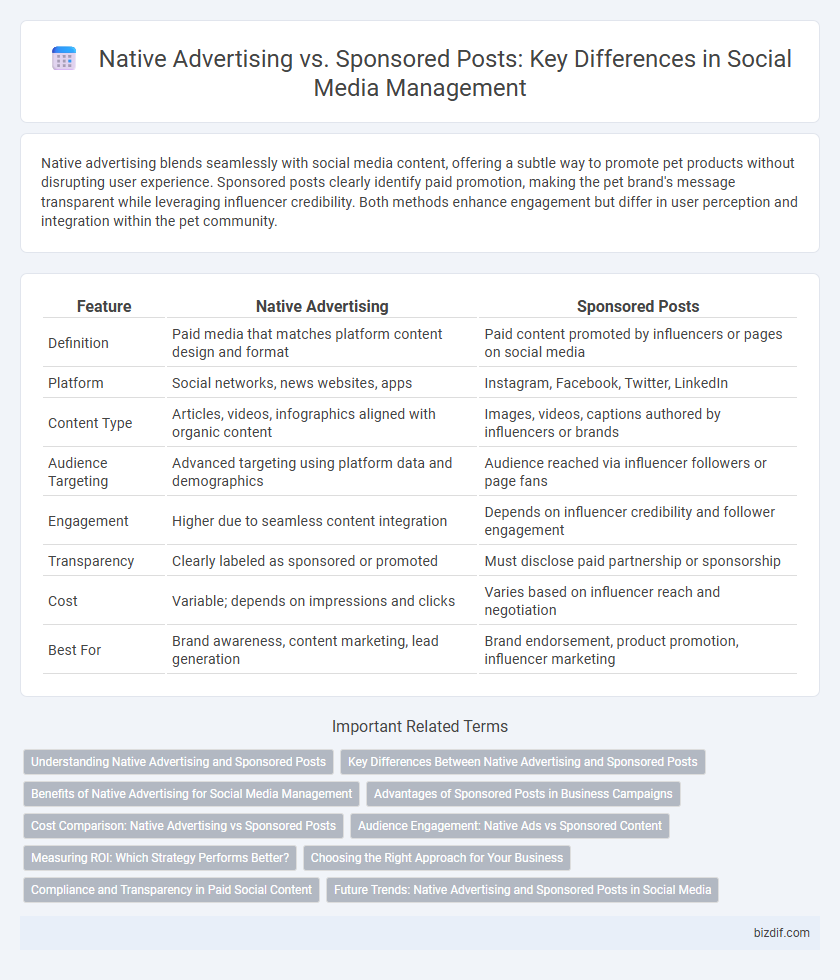Native advertising blends seamlessly with social media content, offering a subtle way to promote pet products without disrupting user experience. Sponsored posts clearly identify paid promotion, making the pet brand's message transparent while leveraging influencer credibility. Both methods enhance engagement but differ in user perception and integration within the pet community.
Table of Comparison
| Feature | Native Advertising | Sponsored Posts |
|---|---|---|
| Definition | Paid media that matches platform content design and format | Paid content promoted by influencers or pages on social media |
| Platform | Social networks, news websites, apps | Instagram, Facebook, Twitter, LinkedIn |
| Content Type | Articles, videos, infographics aligned with organic content | Images, videos, captions authored by influencers or brands |
| Audience Targeting | Advanced targeting using platform data and demographics | Audience reached via influencer followers or page fans |
| Engagement | Higher due to seamless content integration | Depends on influencer credibility and follower engagement |
| Transparency | Clearly labeled as sponsored or promoted | Must disclose paid partnership or sponsorship |
| Cost | Variable; depends on impressions and clicks | Varies based on influencer reach and negotiation |
| Best For | Brand awareness, content marketing, lead generation | Brand endorsement, product promotion, influencer marketing |
Understanding Native Advertising and Sponsored Posts
Native advertising seamlessly integrates promotional content within the platform's user experience, matching the form and function of surrounding non-ad content to ensure higher engagement and reduced ad fatigue. Sponsored posts explicitly label paid content but appear as regular posts, often targeting specific audiences through social media algorithms to boost visibility and interaction. Understanding these distinctions helps marketers optimize campaign authenticity, user trust, and conversion rates on social media channels.
Key Differences Between Native Advertising and Sponsored Posts
Native advertising integrates seamlessly within the platform's natural content flow, matching format and style to enhance user experience and engagement. Sponsored posts are clearly labeled promotional content that appears as standalone ads or branded posts, often more overt in their advertising intent. The key differences lie in native advertising's subtle, content-driven approach versus sponsored posts' direct promotion and clearer disclosure requirements.
Benefits of Native Advertising for Social Media Management
Native advertising enhances social media management by seamlessly integrating promotional content with the platform's organic posts, boosting user engagement and brand credibility. It leverages targeted algorithms to deliver relevant ads that resonate better with audiences, increasing click-through rates and conversion potential. This approach minimizes ad fatigue and fosters a more authentic connection between brands and consumers compared to traditional sponsored posts.
Advantages of Sponsored Posts in Business Campaigns
Sponsored posts offer precise audience targeting based on demographics, interests, and behaviors, enhancing campaign relevance and engagement rates. They provide measurable performance metrics including click-through rates, impressions, and conversions, enabling data-driven optimization. These posts seamlessly blend with organic content, improving user experience and increasing brand credibility within social media platforms.
Cost Comparison: Native Advertising vs Sponsored Posts
Native advertising typically incurs higher costs than sponsored posts due to its seamless integration within content and enhanced targeting capabilities. Sponsored posts often have lower budgets as they appear more overtly promotional and may reach smaller, less targeted audiences. Brands seeking cost-effective social media management may prefer sponsored posts for broad exposure, while investing in native advertising can yield better engagement and ROI despite higher expenses.
Audience Engagement: Native Ads vs Sponsored Content
Native advertising seamlessly integrates with platform content, resulting in higher audience engagement due to its non-disruptive and relevant nature. Sponsored posts often feel more promotional and less organic, leading to lower trust and reduced interaction from users. Studies show native ads can boost click-through rates by up to 60% compared to sponsored content, highlighting their effectiveness in capturing user attention.
Measuring ROI: Which Strategy Performs Better?
Measuring ROI in social media management reveals that native advertising often yields higher engagement rates due to its seamless integration with platform content, boosting brand awareness more effectively than traditional sponsored posts. Sponsored posts provide clearer performance tracking through direct metrics such as click-through rates and conversions, offering more precise ROI calculations. Choosing between native advertising and sponsored posts depends on campaign goals, with native ads excelling in long-term brand building and sponsored posts delivering immediate measurable outcomes.
Choosing the Right Approach for Your Business
Native advertising integrates seamlessly with platform content, enhancing user engagement by matching the format and style of the host site, making it ideal for brands seeking subtle promotion with high trust. Sponsored posts, clearly labeled and often tied to influencer accounts, offer transparent brand messaging and targeted reach within specific audience demographics, suitable for businesses prioritizing direct exposure and measurable ROI. Evaluating factors such as audience preferences, content goals, and budget constraints ensures the selection of the most effective approach to maximize social media marketing impact.
Compliance and Transparency in Paid Social Content
Native advertising integrates promotional content seamlessly within a platform's organic feed, requiring strict adherence to platform-specific disclosure guidelines to ensure compliance and maintain user trust. Sponsored posts must clearly indicate paid partnerships or endorsements through transparent labeling such as "Sponsored" or "Ad" to comply with regulatory standards from entities like the FTC. Failure to maintain transparency in paid social content risks legal penalties, damages brand credibility, and undermines audience engagement.
Future Trends: Native Advertising and Sponsored Posts in Social Media
Future trends in social media management indicate a significant shift towards more sophisticated native advertising strategies that seamlessly blend with user-generated content, enhancing authenticity and engagement rates. Sponsored posts are expected to leverage advanced AI-driven personalization, increasing relevance and boosting conversion while maintaining compliance with evolving transparency regulations. Integrating augmented reality (AR) and interactive elements within both native advertisements and sponsored content will drive immersive brand experiences, reshaping user interaction and measurement metrics.
Native advertising vs Sponsored posts Infographic

 bizdif.com
bizdif.com